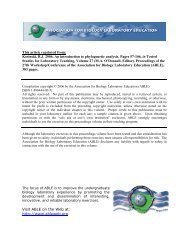A Quantitative Study of Litter and Soil Invertebrates - Association for ...
A Quantitative Study of Litter and Soil Invertebrates - Association for ...
A Quantitative Study of Litter and Soil Invertebrates - Association for ...
You also want an ePaper? Increase the reach of your titles
YUMPU automatically turns print PDFs into web optimized ePapers that Google loves.
76<br />
<strong>Litter</strong> <strong>and</strong> <strong>Soil</strong> <strong>Invertebrates</strong><br />
Student Outline<br />
<strong>Litter</strong> <strong>and</strong> <strong>Soil</strong> <strong>Invertebrates</strong><br />
<strong>Litter</strong> is the term which refers to the non-living organic carpet (dead leaves, grass, twigs, etc.)<br />
covering the soil. It accumulates to varying depths depending on many factors, such as moisture,<br />
pH, soil make-up, temperature, the nature <strong>of</strong> the living vegetative cover (<strong>for</strong>est, meadow, field),<br />
<strong>and</strong> whatever management use man <strong>and</strong> other animals have <strong>for</strong> it (cultivation, mowing, grazing).<br />
<strong>Soil</strong> is a complex system involving the interactions <strong>of</strong> soil, air, <strong>and</strong> water. The inorganic soil<br />
particles, depending on their size <strong>and</strong> arrangement <strong>and</strong> the availability <strong>of</strong> air <strong>and</strong> water, determine<br />
what different groups <strong>of</strong> living organisms, both plants <strong>and</strong> animals, are successful living there.<br />
The smallest animals, <strong>for</strong> example, protozoa, rotifers <strong>and</strong> small nematodes, inhabit not soil proper<br />
but, rather, live in films <strong>of</strong> water enveloping soil particles <strong>and</strong> their aggregates <strong>of</strong> particles.<br />
Physiologically, they are aquatic animals. Mites, collembola (springtails), <strong>and</strong> others that are<br />
larger than protozoa occupy a different habitat in soil; they are active when the spaces between<br />
soil particles are filled with air saturated with water vapour. <strong>Soil</strong>, <strong>for</strong> them, is a system <strong>of</strong> caves in<br />
which they live, utilizing moist air <strong>for</strong> gaseous exchange rather than water. Larger organisms<br />
actually dig passages <strong>and</strong> enter into contact with both solid soil particles <strong>and</strong> water films. For<br />
these invertebrates (earthworms, insect larvae, millipedes) the soil serves as a true habitat.<br />
The interface where litter <strong>and</strong> soil meet is an ecotone <strong>of</strong> a sort. If animals in that interface are<br />
active there is a certain amount <strong>of</strong> mixing between the organic matter <strong>and</strong> the inorganic soil. The<br />
zone <strong>of</strong> mixing is thicker if there are larger, active animals than if bacteria <strong>and</strong> fungi are the main<br />
organisms that decompose the litter there. Normally, in <strong>for</strong>ests, meadows, lawns, roadsides <strong>and</strong><br />
places where fresh plant material is produced seasonally, there are active animals, mostly<br />
invertebrates, that utilize dead plant matter as their main source <strong>of</strong> food.<br />
These dead plant eaters are called detritus feeders or detritovores, as compared with herbivores<br />
<strong>and</strong> carnivores. Detritovores chew up plant matter, extract out <strong>of</strong> it a relatively small amount <strong>of</strong><br />
the nutrition that is there, <strong>and</strong> pass it through their guts to be released as feces. This process<br />
happens repeatedly in a succession <strong>of</strong> different kinds <strong>of</strong> animals until the nutrition is gone—<br />
recycled—into the new protoplasm <strong>of</strong> living plants <strong>and</strong> animals.<br />
In this exercise you will examine <strong>and</strong> learn to recognize the invertebrates found in litter <strong>and</strong><br />
the litter-soil interface. These resident invertebrates have already been collected <strong>for</strong> you.<br />
The method used <strong>for</strong> separating these animals from litter <strong>and</strong> soil is the Berlese Method. The<br />
sample was placed in a funnel-shaped cone about 40 cm in length. The wide end <strong>of</strong> the cone was<br />
upright <strong>and</strong> covered with a hood containing a light bulb. The narrow end <strong>of</strong> the cone was down<br />
<strong>and</strong> inserted into a bottle containing 70% alcohol. With the light bulb burning, the light <strong>and</strong> heat<br />
that were produced created gradients <strong>of</strong> three different physical conditions. All three gradients<br />
caused animals to move downward <strong>and</strong>, if they could make it all the way, into the alcohol where<br />
they were preserved. In such a set up, what are the three gradients produced by lighting the bulb?<br />
Observe the group <strong>of</strong> four Berlese funnels on demonstration in the laboratory <strong>for</strong> ideas. Obviously<br />
not all kinds <strong>of</strong> animals found in the samples would be able to move through the sample to the<br />
alcohol. These animals will not be represented in the sample you examine. What sorts <strong>of</strong> animals<br />
do you think would not be represented (refer to the second paragraph <strong>of</strong> this exercise)?<br />
The samples available in the laboratory have been obtained from a variety <strong>of</strong> habitats:<br />
deciduous <strong>for</strong>est, conifer <strong>for</strong>est, sod from fence rows, lawns, meadows, campus, etc. The sample<br />
you will examine is labelled so you know its source.
















